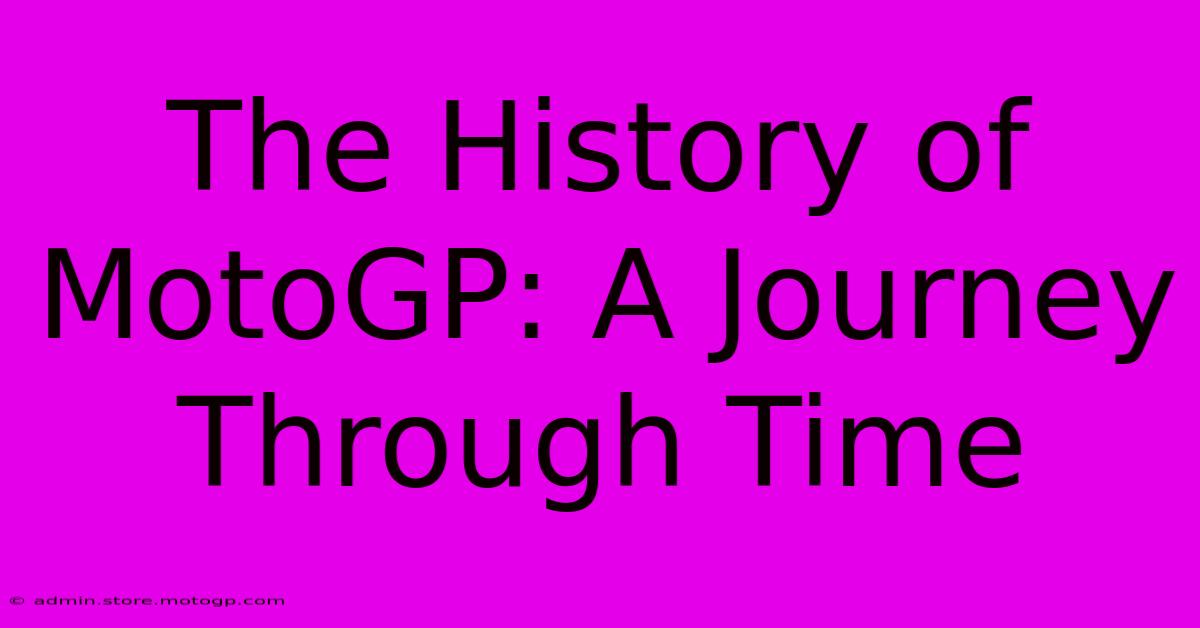The History Of MotoGP: A Journey Through Time

Table of Contents
The History of MotoGP: A Journey Through Time
Motorcycle racing has a rich and captivating history, evolving from humble beginnings to the technologically advanced and globally televised spectacle we know today as MotoGP. This article delves into the fascinating journey of MotoGP, exploring its key eras, iconic riders, and pivotal moments that shaped the sport into the powerhouse it is now.
The Early Days: From Club Races to Grand Prix (Pre-1949)
The origins of what we now know as MotoGP are rooted in the early days of motorcycle manufacturing and club racing. Races were often held on public roads, with varying regulations and a fierce spirit of competition. These early events laid the groundwork for the future, establishing a foundation of speed, skill, and daring that persists to this day. While a formal championship structure wasn't yet in place, these formative years saw the emergence of pioneering riders and manufacturers who would become legendary names in motorcycle racing history. Think of these early races as the seed that grew into the mighty tree of MotoGP.
Key Characteristics of this Era:
- Varied regulations: Rules and classes were inconsistent across different races.
- Public road racing: Many races were held on dangerous, unpredictable public roads.
- Technological innovation: Manufacturers constantly strived for improvements in engine technology and chassis design.
The Formation of the Grand Prix Motorcycle Racing World Championship (1949-1970s)
The year 1949 marks a significant milestone: the official establishment of the Fédération Internationale de Motocyclisme (FIM) Grand Prix Motorcycle Racing World Championship. This marked a move towards standardization and a more structured championship format. The initial classes were 125cc, 250cc, 350cc, and 500cc, with fierce competition among manufacturers and riders from across Europe. This era witnessed the rise of legendary riders who pushed the boundaries of motorcycle racing.
Defining Moments and Key Players:
- Geoff Duke's dominance: The British rider dominated the 350cc and 500cc classes in the early 1950s.
- The rise of Japanese manufacturers: Honda, Yamaha, and Suzuki began to make their mark, introducing innovative technology and challenging established European teams.
- Increased safety measures: Although still dangerous, the sport gradually saw the introduction of safety improvements.
The Evolution of Technology and the Rise of Global Competition (1980s-1990s)
The 1980s and 1990s saw a dramatic increase in technological advancement and global participation in MotoGP. Two-stroke engines reigned supreme, delivering incredible power and speed. Legendary riders like Wayne Gardner, Kevin Schwantz, and Mick Doohan captivated audiences with their breathtaking skills and fierce rivalry. This period was also characterized by increased media coverage, further boosting the sport's popularity worldwide.
Technological Advancements:
- Refinement of two-stroke technology: Engines became more powerful and reliable.
- Aerodynamic improvements: Fairings and bodywork became increasingly sophisticated.
- Improved suspension and braking systems: These advancements enhanced rider control and safety.
The Four-Stroke Revolution and Modern MotoGP (2000s-Present)
The dawn of the new millennium brought a revolutionary change: the switch to four-stroke engines in the premier class (MotoGP). This shift marked a significant technological leap, introducing new challenges and opportunities for manufacturers and riders. The four-stroke era saw the emergence of new stars like Valentino Rossi, Jorge Lorenzo, Marc Marquez, and Casey Stoner, whose fierce battles and incredible skill enthralled fans worldwide. MotoGP today is a global phenomenon, a technologically advanced spectacle, and a testament to the enduring appeal of motorcycle racing.
Defining Features of Modern MotoGP:
- Sophisticated electronics: Traction control, launch control, and sophisticated data acquisition systems are commonplace.
- Global appeal: The sport attracts huge audiences from around the world.
- High-tech materials: Carbon fiber, titanium, and advanced composites are used extensively in bike construction.
The Future of MotoGP
MotoGP continues to evolve, with ongoing technological advancements and a constant drive for innovation. Sustainability is also becoming a key focus, with manufacturers exploring alternative fuels and environmentally friendly technologies. The future promises even faster bikes, closer racing, and a continued expansion of the sport’s global reach. The legacy of the past, however, remains, influencing and shaping the exciting future of this exhilarating sport. The spirit of competition, the daring skill of the riders, and the cutting-edge technology will undoubtedly ensure that MotoGP remains a thrilling and captivating spectacle for years to come.

Thank you for visiting our website wich cover about The History Of MotoGP: A Journey Through Time. We hope the information provided has been useful to you. Feel free to contact us if you have any questions or need further assistance. See you next time and dont miss to bookmark.
Featured Posts
-
Cota Store Experience The Excitement Of Racing
Feb 19, 2025
-
Moto2 Standings 2025 The Definitive Guide To The Championship
Feb 19, 2025
-
Moto Gp Streams The Ultimate Guide To Watching Moto Gp Online Free
Feb 19, 2025
-
Us Gp Concerts The Best Weekend Of The Year
Feb 19, 2025
-
Aerodynamics The Key To Moto Gps Thrilling Races
Feb 19, 2025
